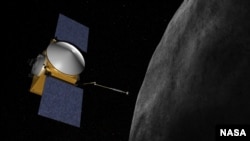Two ancient Egyptian deities are set to rendezvous in space later this decade, but it's a meeting of a scientific, not mythological, kind.
The U.S. space agency, NASA, announced Wednesday that Asteroid (101955) 1999 RQ36 has been renamed Bennu after an ancient Egyptian deity that is often depicted as a gray heron.
Bennu will get a visit from a NASA spacecraft called OSIRIS-REx, more formally known as Origins-Spectral Interpretation-Resource Identification-Security-Regolith Explorer.
The spacecraft's arm will collect a sample of Bennu and store it for return to Earth.
The spacecraft shares its moniker with Osiris, the ancient Egyptian god of the underworld also worshipped for agriculture. Bennu and Osiris are often connected in Egyptian stories.
The space agency says 8,000 students from more than 20 countries entered a contest to give Asteroid (101955) 1999 RQ36 a new moniker. Nine-year-old Michael Puzio of the southeastern U.S. state of North Carolina suggested the winning name.
In a news release, NASA said Puzio envisioned OSIRIS-REx's sampling arm and solar panels as resembling the neck and wings of the mythical Bennu.
OSIRIS-REx is set to launch in 2016, rendezvous with asteroid Bennu in 2018 and return a piece of the primordial space rock to Earth in 2023. Scientists say the sample could hold clues to the origins of the solar system.
Asteroid (101955) 1999 RQ36's original name indicates it was discovered in 1999, and it was the 101,955th confirmed asteroid.
The U.S. space agency, NASA, announced Wednesday that Asteroid (101955) 1999 RQ36 has been renamed Bennu after an ancient Egyptian deity that is often depicted as a gray heron.
Bennu will get a visit from a NASA spacecraft called OSIRIS-REx, more formally known as Origins-Spectral Interpretation-Resource Identification-Security-Regolith Explorer.
The spacecraft's arm will collect a sample of Bennu and store it for return to Earth.
The spacecraft shares its moniker with Osiris, the ancient Egyptian god of the underworld also worshipped for agriculture. Bennu and Osiris are often connected in Egyptian stories.
The space agency says 8,000 students from more than 20 countries entered a contest to give Asteroid (101955) 1999 RQ36 a new moniker. Nine-year-old Michael Puzio of the southeastern U.S. state of North Carolina suggested the winning name.
In a news release, NASA said Puzio envisioned OSIRIS-REx's sampling arm and solar panels as resembling the neck and wings of the mythical Bennu.
OSIRIS-REx is set to launch in 2016, rendezvous with asteroid Bennu in 2018 and return a piece of the primordial space rock to Earth in 2023. Scientists say the sample could hold clues to the origins of the solar system.
Asteroid (101955) 1999 RQ36's original name indicates it was discovered in 1999, and it was the 101,955th confirmed asteroid.










